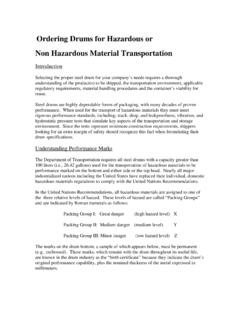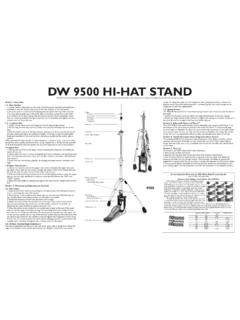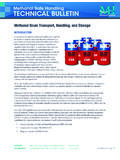Transcription of 2003 Plastic Drum Paneling Issues
1 2003 Plastic drum Paneling IssuesDrums are relatively thin-walled packages whether they are steel, fiber or Plastic . They are not intended to be pressure vessels. However, in some industrial applications they are subjected to pressure influences both internal and external. In many cases, the pressures exerted are within the tolerances acceptable for that package. When the pressures exerted on the package are outside the acceptable tolerance ranges, a distortion may be seen in the outer surface of the package. This phenomenon is usually referred to as problem of Paneling has three possible causes: the temperature differential across the container is too great, the lading being packaged is a strong permeator, or the lading being packaged is a strong oxygen scavenger. A significant increase in atmospheric pressure (relative to the atmospheric pressure when the container was initially sealed) can cause a package that is relatively stressed near the point of Paneling (by some other cause) to actually begin to of the causes of Paneling have solutions.
2 If a temperature difference is causing the problem, use the results provided in the Paneling test to determine a maximum temperature range for your container and either allow sufficient time for the lading to cool to an acceptable temperature or utilize plugs with venting systems in your containers. If you suspect a compatibility problem between your lading and the container, please speak with your polyethylene material supplier. They can have your lading tested according to the Department of Transportation (DOT) procedures provided in this report. A problem with oxygen scavenging is easily remedied by placing a blanket of nitrogen gas over the liquid being packaged. This report will explain the causes of Paneling and suggest some possible ways to eliminate or minimize the Paneling of Plastic of Container Paneling1. Changes in the temperature of the lading being packaged2. Permeation of the lading into the wall of the container3. Storage of an oxygen scavenger lading in the container4.
3 Changes in atmospheric pressure conditionsA container panels because the pressure inside the drum has become significantly less than the pressure outside the drum . All of the above reasons for the Paneling of containers have this same effect they change the pressure differential across the container. The question then is, how much pressure difference is too much? The results of the following Paneling Test for Plastic Containers provide the answers on a case-by-case Plastic drum showing MORE INFORMATION, PLEASE VISIT Test for Plastic ContainersTest Purpose and ScopeThe purpose of this test is to determine the amount of vacuum a given container can sustain before Paneling occurs. Each type of container will be tested both empty and filled with ListQuincy air compressor, Model QSI 235 McDaniel Controls vacuum gauge, 0 to 30 inches Hg full scaleNorgren air pressure regulator, Model 11-018-100 Festo vacuum generator, Type VAD 3/8 Test Procedure1. Perform this test at ambient conditions (c.)
4 70 F).2. Obtain two samples of each type of container. Fill one of the samples with water to about 5 inches below the bung Plug the bung opening of the drum , as necessary. Using a punched-out 2-inch NPT plug, attach the test apparatus to the drum . Connect the compressor air line to the test apparatus and set the initial vacuum to 1 inch Hg using the pressure Once the vacuum in the drum reaches 1 inch of Hg, wait for two minutes. This will allow time for the sidewall of the drum to relax and adjust to the new Using the pressure regulator, increase the vacuum in the drum by inches Hg and again allow 2 minutesto Repeat Step 5 until the head of the drum draws in and record the Continue to repeat Step 5 until Paneling begins to occur and record this Detach the compressor airline from the test apparatus and allow the vacuum in the drum to reach ZERO. Remove the test apparatus from the Repeat Step 3 through Step 8 for all containers that are to be and ObservationsA filled container will always withstand a greater vacuum than an empty one because the lading places outward pressure on the container sidewall.
5 This outward pressure counteracts a part of the vacuum applied to the a given container begins to panel, it will continue to panel until the amount of the vacuum in the container decreases by approx. psi. This reduction in vacuum normally occurs as the container walls panel. Paneling reduces the volume of the container and as a result, the vacuum inside the container. This means that a container will only panel to a limited degree, that is, until the vacuum inside the container drops just enough that Paneling can no longer occur (in most cases this is approx. psi). However, in this test we held a constant vacuum on the test container. This caused the container to continue to panel until severe distortion of the sidewall occurred. Also, once a container sidewall has buckled due to Paneling , it will require less vacuum to cause the container to panel again. The reduction in Paneling pressure is proportional to the severity of the previous Paneling Paneling pressure is also dependent on the temperatures of the container s sidewall: if the container is hot, the sidewall is more ductile and will deform more Due to a Temperature DifferentialDiagram A and B show the amount of vacuum induced within a drum as a function of the temperature differential between a drum s contents and its surroundings (or inside and outside).
6 These diagrams can be used in combination with the results from the Paneling test to predict if a drum will panel given the temperature differential across the cause of Paneling can be eliminated in one of four Allow lading to cool longer before filling the container. Using the results of the Paneling test, one can determine a maximum temperature differential for a given container and calculate the maximum allowable temperature for the lading being Allow lading to cool longer after filling but before Do not store the packaged goods in a location that is cooler than the filling temperature by an amount exceeding the maximum Utilize a venting drum INSTITUTE | 2003 1 2 3 4 5 6 7 8 9 10 11 12 13 14 15 16 17 18 19 20 21 22 23 24 25 26
7 27 28 29 30 31 32 33 34 35 36 37 38 39 40 41 42 Due to Strong PermeatorsPaneling can be caused by a chemical incompatibility between the lading and the container. The result is permeation of the lading into the walls of the container. This reduces the pressure inside the container and cause Paneling . The DOT has a specific test to determine the compatibility of liquid materials packaged in Plastic containers. A copy of the test is included on the next PROCEDURE FOR TESTING CHEMICAL COMPATIBILITY AND RATE OF PERMEATION IN Plastic PACKAGING AND RECEPTACLESA ppendix B to Part 1731. The purpose of this procedure is to determine the chemical compatibility and permeability of liquid hazardous materials packaged in Plastic packaging and receptacles.
8 Alternatives for this procedure are permitted as specified in part (e) (3) (iii) of this Compatibility and rate of permeation are determined by subjecting full size Plastic containers (or smaller containers as permitted in paragraph 4 of this Appendix) and hazardous material lading to Test Method 2: 28 days at a temperature no lower than 50 C (122 F).3. At least three sample containers shall be tested for each combination of hazardous material and size and design of container. Fill the containers to rated capacity with the specific hazardous material (at the concentration to be transported) and close as for shipment. For the first and last 24 hours of storage, place the containers with closures pointed downward, except that containers fitted with a vent are so placed on each occasion for five minutes vs. Temperature DifferentialTemperature ( F) Vacuum (psig)Diagram A: Table showing amount of vacuum induced within a drum as a function of B: Paneling effect3 Plastic drum INSTITUTE | 20034.
9 In those instances where it is not practicable to use full size containers, smaller containers may be used. The smaller container shall be manufactured by the same process as the larger container ( using the same method of molding and processing temperatures) and be made of identical resins, pigments and Determine filled container weight or net weight of contents both before and after storage. Rate of permeation is determined from loss of hazardous materials contents, during the test exposure time, expressed as a percentage of the original After storage, the container shall be drained, rinsed, filled to rated capacity with water at ambient temperature, dropped from a height determined in accordance with part (d) of this subchapter onto a rigid non-resilient, flat and horizontal Each of the following constitute test failure: Visible evidence of permanent deformation due to vapor pressure build-up or collapse of walls, deterioration, swelling, crazing, cracking, excessive corrosion, oxidation, embrittlement, leakage, rupture or other defects likely to cause premature failure or a hazardous condition.
10 For materials meeting the definition of a poison according to this subchapter, a rate of permeation in excess of determined over the test period. For all other hazardous materials, a rate of permeation in excess of determined over the test Due to Oxygen ScavengersAnother cause of Paneling is storage of goods that deplete the oxygen inside the container. These types of liquids react with and consume the oxygen in the airspace between the liquid and the head of the container. As this occurs, the air pressure inside the container drops (due to loss of the oxygen into the liquid) and the container may panel. A simple solution to this problem is to displace the air above the liquid with a heavier inert gas (such as nitrogen), before sealing the Due to Product AbsorptionProduct absorption occurs from the inside of the drum in contact with the lading and generally will be present as a gradient across the wall thickness. Depending on the products tendency to cause swelling of the polyethylene there will be a differential growth across the thickness resulting in the inner layer growing faster than the outer layers.







